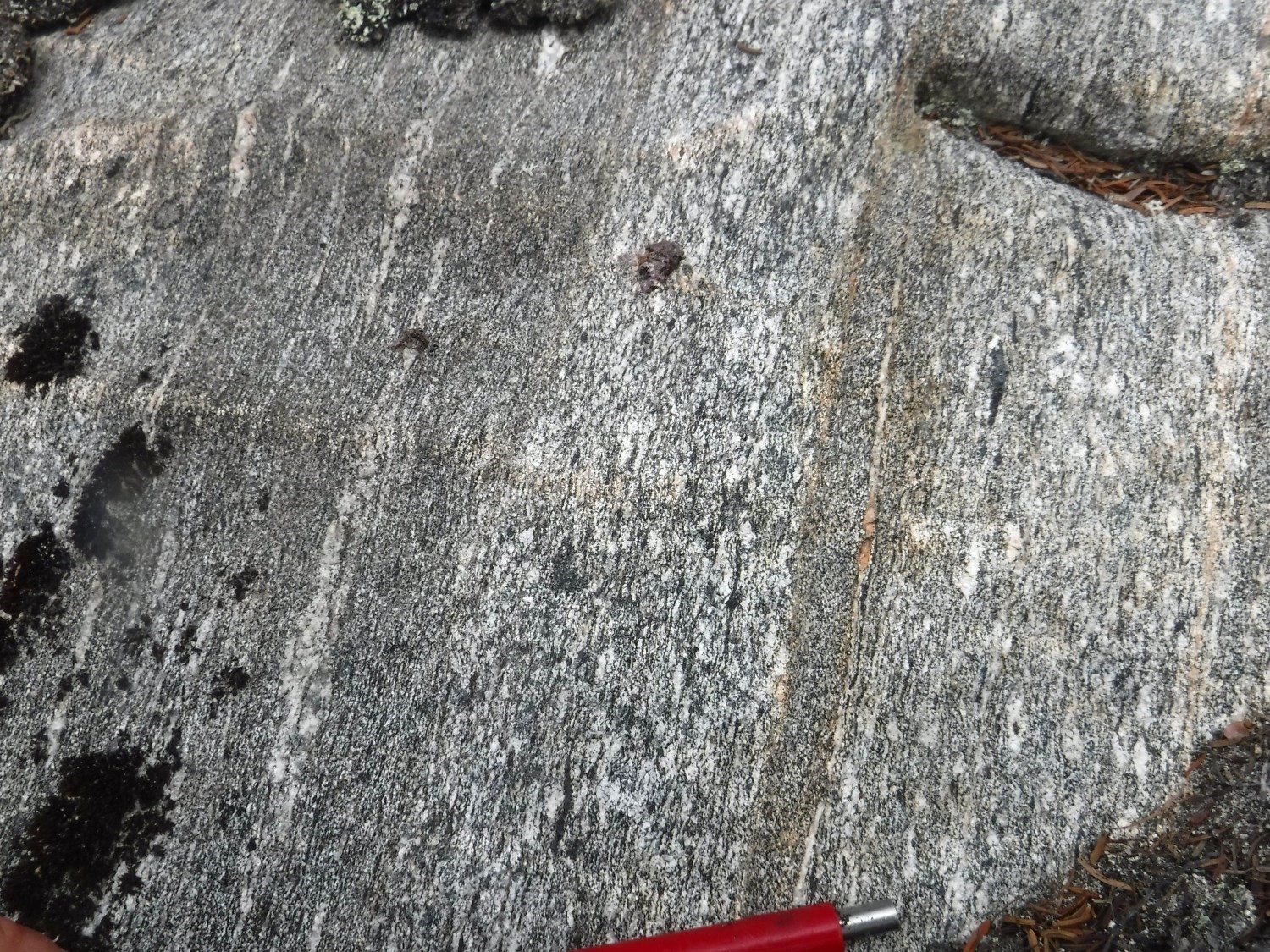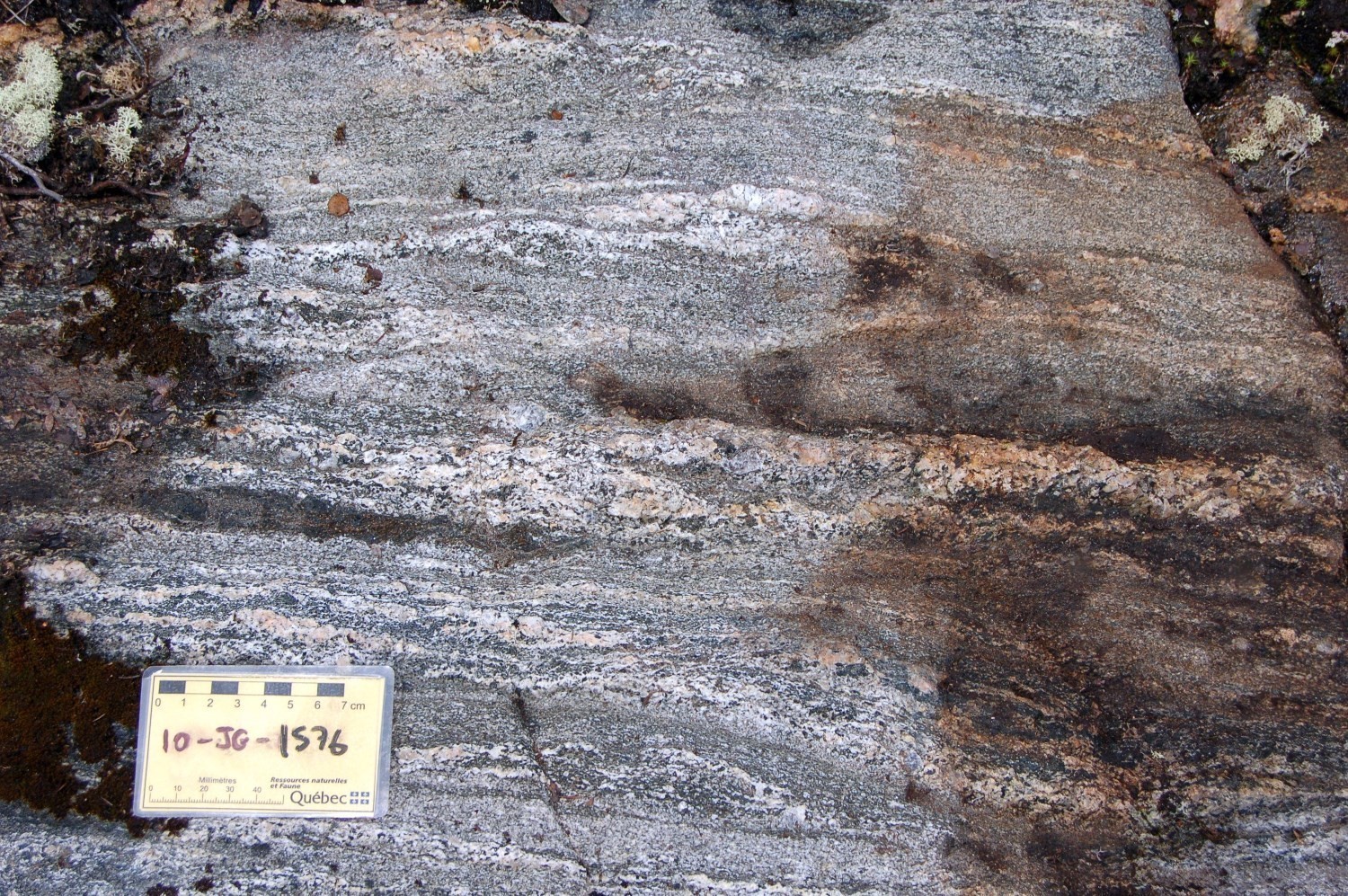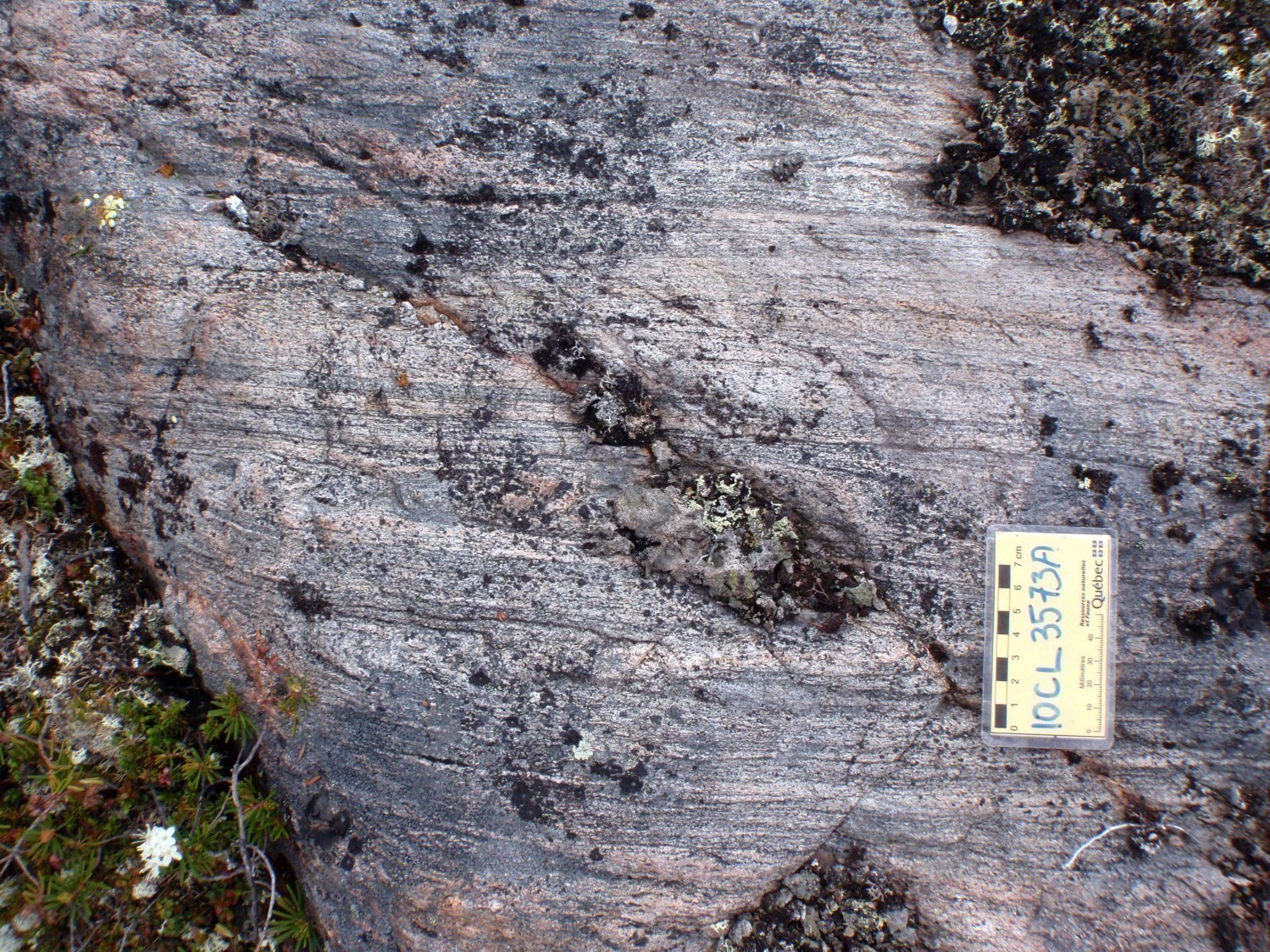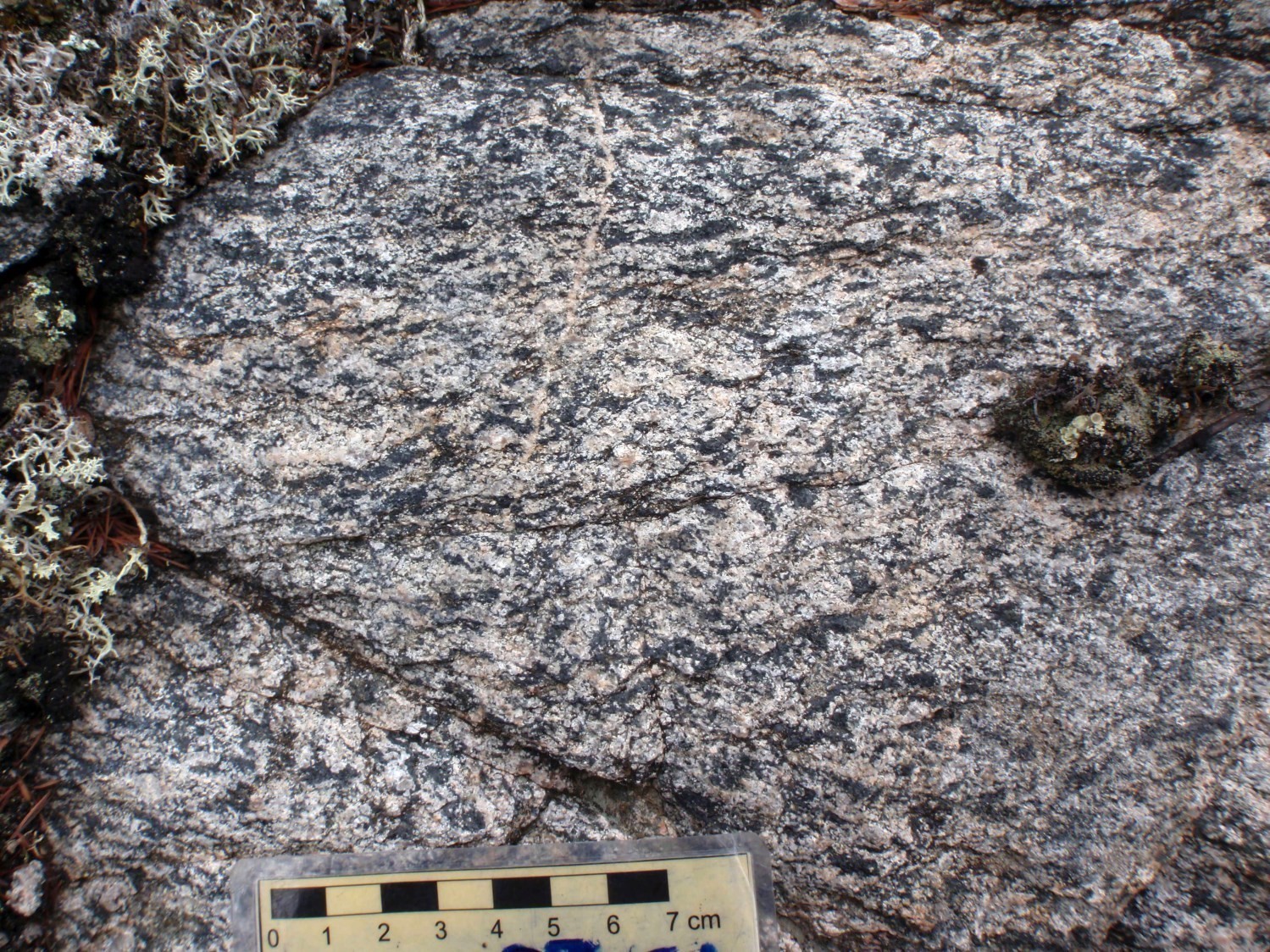
| Author: | Charette et al., 2019 |
| Age: | Archean; Paleoproterozoic |
| Stratotype: | None |
| Type area: | Mistinibi Lake area (NTS sheet 23P15) |
| Geological province: | Churchill Province |
| Geological subdivision: | Mistinibi-Raude Lithotectonic Domain |
| Lithology: | Felsic to intermediate gneiss and associated intrusions |
| Category: | Lithodemic |
| Rank: | Complex |
| Status: | Formal |
| Use: | Active |
None
Background
The Advance Complex was defined and incorporated into the SIGÉOM compilation map by Charette et al. (2019) as a result of fieldwork in the summer of 2016 and as part of the Southeastern Churchill Province (SECP) regional synthesis (Lafrance et al., 2018). This complex consists of a package of felsic to intermediate gneiss and deformed intrusions. These lithologies were first recognized in the Leif Lake (Owen, 1989), Hutte Sauvage Lake (van der Leeden, 1994), Mistinibi Lake (van der Leeden, 1995) and Zeni Lake (Hammouche et al., 2012) areas. In the Rivière George Shear Zone area, Advance Complex units were initially associated with the George Complex, an assemblage of gneiss of uncertain protolith. This latter unit, which grouped highly deformed rocks that included metavolcanics, metavolcaniclastics, paragneiss, orthogneiss and intrusions, was abandoned as part of the SECP regional synthesis.
The unit name comes from the Advance lake, located in NTS sheet 23P07.
Description
The Advance Complex consists mainly of granitic to monzodioritic gneiss containing decametric to kilometric zones of dioritic and quartz dioritic gneiss. Gneiss are commonly injected by centimetric to decimetric pinkish granite bands subparallel to gneissosity. Locally, kilometric deformed intrusions are associated with these gneiss. The Advance Complex is divided into three informal units: 1) dioritic gneiss (ApPadv1); 2) monzogranitic and monzodioritic gneiss (ApPadv2); and 3) foliated monzodiorite and quartz diorite (ApPadv3).
Gneiss and intrusions of the Advance Complex are affected by regional deformation corridors such as the Rivière George and Zeni shear zones. Within these corridors, gneiss banding becomes more regular and straight (upright gneiss) and there is a significant decrease in grain size. In places, these deformation zones exhibit significant alteration, the main ones being chloritization, sericitization, hematitization and carbonatization.
Advance Complex 1 (ApPadv1): Dioritic to Quartz Dioritic Gneiss
Unit ApPadv1 consists of dioritic to quartz dioritic gneiss. This lithology had previously been recognized in the Mistinibi Lake (unit E1c of van der Leeden, 1995) and Leif Lake (unit E1e of Owen, 1989 and Danis, 1991) areas. In the Zeni Lake area, Hammouche et al. (2012) included dioritic gneiss in a undifferentiated gneiss unit (M1h). This unit was reassigned to the ApPadv1 unit by Charette et al. (2019).
The medium to dark grey gneiss of unit ApPadv1 is fine to medium grained and locally magnetic. It commonly displays a banded texture associated with the presence of pinkish to whitish injections conformable to subconformable to gneissosity and with variations in mafic mineral content (20-35%). In places, a speckled appearance is given by lenticular clusters of mafic minerals, small plagioclase porphyroclasts and millimetric green hornblende porphyroblasts locally poikilitic. In thin sections, the rock is partially recrystallized and commonly has deformation zones oblique to gneissosity that are marked by significant grain reduction. Mafic minerals include zoned hornblende (green in the centre to bluish green in the edge) and brown biotite in smaller amounts. Sphene and epidote are present in significant amounts (1-4%) and form small clusters aligned in gneissosity. Other accessory phases include opaque minerals, allanite (commonly found in the core of epidote crystals), zircon, apatite and monazite. Unit ApPadv1 also contains a homogeneous, granoblastic and foliated pepper and salt diorite that forms, in places, centimetric to decimetric layers inserted in dioritic gneiss.
Advance Complex 1a (ApPadv1a): Foliated Diorite and Quartz Diorite
In the NE part of the Zeni Lake area (sheets 23P01 and 13M04), subunit ApPadv1a consists of foliated diorite and quartz diorite, locally mylonitized, fine to medium-grained and locally magnetic. These lithologies, previously included in the lithological division “I2Ja” of Hammouche et al. (2012), were described as migmatized rocks locally containing paragneiss and gneissic tonalite enclaves. Granitic to granodioritic bands form 10-40% of the rock. These bands contain 15-50% mafic minerals, mainly hornblende and biotite, and locally contain K-feldspar porphyroclasts 1-2 cm long. Metric amphibolite layers or clusters represent 5-40% of the outcrops’ surface.
Advance Complex 2 (ApPadv2): Monzogranitic and Monzodioritic Gneiss
Unit ApPadv2 gneiss is monzogranitic to monzodioritic. This lithology had been recognized in the Leif and Mistinibi Lakes areas, where it had been assigned to a unit of undifferentiated plutonic rocks (F1d, Owen, 1989; F1ce, van der Leeden, 1995).
Gneiss is grey to pinkish grey with a lighter alteration patina. The gneissic and banded texture is highlighted by moderate to high segregation of mafic minerals, by the presence of millimetric to centimetric bands of whitish to pinkish leucocratic granite (10-30%), and by centimetric to decimetric pinkish granitic intrusions subconformable to gneissosity. Granitic bands are discontinuous, lenticular and porphyroclastic, while intrusions are coarser grained and occasionally porphyroclastic. Locally, a high concentration of bands and intrusions is associated with chaotic banding that gives the gneiss an appearance of migmatite. The rock is variably magnetic. Centimetric to metric layers of diorite similar to that of unit ApPadv1 are also inserted in monzogranitic to monzodioritic gneiss. In thin sections, unit ApPadv2 gneiss is moderately recrystallized and mafic minerals (5-20%) are concentrated in laminae. Grain edge recrystallization is common and matrix minerals locally show a preferential orientation that emphasizes the extensive deformation of gneiss. Hornblende or biotite is the dominant mafic mineral, but both are consistently present. Hornblende locally forms millimetric porphyroblasts. Epidote and sphene are observed in notable amounts (1-3%) in association with mafic laminae. Accessory minerals include opaque minerals, allanite (associated with epidote), apatite and carbonates. In places, strong hematite alteration gives a dark pink patina to the rock.
Advance Complex 2a (ApPadv2a): Mylonitized Monzogranite, Diorite, Quartz Diorite, Tonalite and Granite
In the NE part of the Zeni Lake area (sheets 23P01 and 13M04), subunit ApPadv2a consists of alternating mylonitized felsic and intermediate rocks (monzogranite, diorite, quartz diorite, tonalite and granite). These rocks were previously assigned to lithological unit “T2a” and in part to unit “M4a” of Hammouche et al. (2012); the latter grouped felsic to intermediate paragneiss and gneiss (now assigned to the Advance Complex). Subunit ApPadv2a rocks are fine to medium grained, and display a banded to gneissic texture marked by millimetric to centimetric bands richer in ferromagnesian minerals, as well as by the common presence of quartz bands. Minerals are highly stretched and 1-3 cm K-feldspar porphyroclasts are observed in places. Garnet locally occurs as poikilitic porphyroclasts. These rocks may also contain magnetite, clinopyroxene, orthopyroxene, epidote and apatite. Alteration is marked by the presence of epidote, sericite and chlorite. Highly foliated and fine-grained amphibolite enclaves or decametric layers are present here and there in mylonitic rocks. These mafic rocks are composed of hornblende, actinolite, plagioclase and lower amounts of biotite, locally euhedral garnet (1-7%), clinopyroxene (1-2%), magnetite and, more sparsely, quartz (<5%).
Advance Complex 3 (ApPadv3): Foliated Monzodiorite and Quartz Diorite
Unit ApPadv3 consists of deformed monzodioritic to quartz dioritic intrusions, locally granitic. The medium-grained rock has a variable colour depending on its composition (pinkish grey, pinkish, or black and grey speckled). Lenticular porphyroclasts (0.5-2 cm) of recrystallized plagioclase and K-feldspar are commonly observed. Mafic minerals (biotite and hornblende) form 10-25% of the rock and occur in laminae or lenticular clusters marking a well-developed foliation. In thin sections, partial recrystallization of the matrix is observed between porphyroclasts. Epidote (1-2%) is associated with mafic minerals and contains local allanite cores. Accessory minerals include opaque minerals, sphene and apatite. There is some evidence of decimetric to metric layers or enclaves of fine-grained diorite similar to that of unit ApPadv1.
Thickness and Distribution
The Advance Complex forms a 5 to 10 km-wide strip in the west-central and south portions of the Mistinibi-Raude Lithotectonic Domain (Charette et al., 2019). This strip, generally oriented N-S in the northernmost portion of the complex, turns to the NW-SE in the Zeni Lake area farther south. Hectometre to kilometre-thick klippes are also found in paragneiss and migmatites of the Mistinibi Complex (pPmis). Unit ApPadv2 (1015 km2) covers the largest area. Unit ApPadv1 (159 km2) and subunits ApPadv1a (126 km2) and ApPadv2a (68 km2) cover smaller areas. Unit ApPadv3 (38 km2) forms stretched and locally folded intrusions of 0.5 to 1.5 km in thickness.
Dating
No lithology associated with the Advance Complex has been dated. However, the Zeni Complex includes a tonalitic to granitic mylonite unit (ApPzen2) located in their extension. These rocks are similar to Advance Complex felsic to intermediate gneiss and have been dated ~2480 Ma (David et al., 2009).
Stratigraphic Relationship(s)
The Advance Complex is the main orthogneiss unit of the Mistinibi-Raude Lithotectonic Domain and appears to be the bedrock in this area. All the lithologies of the Advance Complex are intruded by granitoids of the Dumans Suite (pPdmn) and occur as enclaves in them in some places. Advance Complex gneiss form klippes in paragneiss and migmatites of the Mistinibi Complex (pPmis) and are paralleled in the tectonic grain or folded along.
In the Zeni Lake area (sheets 23P01 and 23I16), tonalitic to granitic mylonites, intermediate in places, were associated with the Zeni Complex (ApPzen2) by Hammouche et al. (2012). Structural continuity and lithological similarity between units ApPadv2 and ApPzen2 could indicate a genetic link between them.
Paleontology
Does not apply.
References
| Author(s) | Title | Year of Publication | Hyperlink (EXAMINE or Other) |
|---|---|---|---|
| DANIS, D. | Géologie de la région du lac Raude, Territoire-du-Nouveau-Québec. Ministère de l’Énergie et des Ressources, Québec; ET 88-10, 73 pages, 5 plans. | 1991 | ET 88-10 |
| DAVID, J. – MOUKSHIL, A. – CLARK, T. – HÉBERT, C. – NANTEL, S. – DION, C. – SAPIN, A.-A. | Datation U-Pb effectuées dans les provinces de Grenville et de Churchill en 2006-2007. Ministère des Ressources naturelles et de la Faune, Québec; RP 2009-03, 32 pages. | 2009 | RP 2009-03 |
| HAMMOUCHE, H. – LEGOUIX, C. – GOUTIER, J. – DION, C. | Géologie de la région du lac Zeni. Ministère des Ressources naturelles, Québec; RG 2012-02, 35 pages, 1 plan. | 2012 | RG 2012-02 |
| LAFRANCE, I. – CHARETTE, B. – VANIER, M.-A. |
Sud-est de la Province de Churchill, Nunavik, Québec, Canada : synthèse de la géologie. Ministère de l’Énergie et des Ressources naturelles, Québec. |
2018 | Bulletin géologiQUE |
| CHARETTE, B. – LAFRANCE, I. – VANIER, M.-A. – GODET, A. | Domaine de Mistinibi-Raude, sud-est de la Province de Churchill, Nunavik, Québec, Canada : synthèse de la géologie. Ministère de l’Énergie et des Ressources naturelles. BG 2019-07. | 2019 | BG 2019-07 |
| OWEN, J. V. | Géologie de la région du lac Leif, Territoire-du-Nouveau-Québec. Ministère de l’Énergie et des Ressources, Québec; ET 87-18, 56 pages, 3 plans. | 1989 | ET-87-18 |
| VAN DER LEEDEN, J. | Géologie de la région du lac de la Hutte Sauvage, Territoire-du-Nouveau-Québec. Ministère de l’Énergie et des Ressources; MB 94-32, 109 pages, 2 plans. | 1994 | MB 94-32 |
| VAN DER LEEDEN, J. | Géologie de la région du lac Mistinibi, Territoire-du-Nouveau-Québec. Ministère des Ressources naturelles, Québec; MB 95-45, 107 pages, 3 plans. | 1995 | MB 95-45 |





